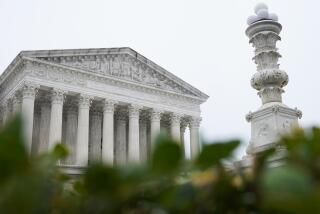California Supreme Court weighs Senate election districts
- Share via
The California Supreme Court expressed concern Tuesday that there might be too little time to redraw new voter maps for this year’s state Senate elections even though the existing political boundaries could be put on hold pending a November referendum.
During a special session, the state high court grappled with which alternative election maps to use should the court determine that a proposed referendum on the issue is likely to qualify for the November ballot.
“There simply in this particular case isn’t sufficient time to come up with a so-called model plan,” said Justice Joyce L. Kennard.
A nonpartisan citizens commission, established by ballot initiative, adopted new election maps last summer for the state’s 40 Senate districts. Republicans said the plan would reduce their numbers in the Legislature, possibly so much that Democrats would have the two-thirds majority needed to raise taxes.
After unsuccessfully challenging the constitutionality of the new districts, a group backed by Republicans circulated petitions for a November referendum to scrap the new maps.
If the referendum qualifies for the ballot, the current maps would be “stayed” or placed on hold pending the November election.
Republicans have asked the California Supreme Court to adopt new Senate districts in time for the state’s June 5 primary, when 20 Senate seats are up for grabs. Most candidates have until March 9 to file their intention to run.
During Tuesday’s hearing, justices questioned whether they had authority to adopt new maps and, if so, which maps could be approved given the looming election deadlines.
Justice Goodwin Liu expressed concern about the prospect of adopting new voter maps when there was a chance the referendum would not qualify. “What should happen if the referendum does not qualify and then there is a published opinion by this court?” he asked.
The sponsors have expressed confidence the referendum will qualify, but an attorney for Secretary of State Debra Bowen told the court that she was “not prepared to say” at this date that the measure was likely to make it to the ballot, a point that frustrated Justice Marvin R. Baxter.
If the court waited until the measure qualified, it might be “too late to do anything,” Baxter said.
Counties had until 5 p.m. Tuesday to report the results of their random checks of signatures for the referendum. It appeared that those counts did not yield a high enough percentage to qualify the referendum and that a full count of the more than 711,000 signatures collected would be required.
The measure needs 504,760 valid signatures to qualify for the November ballot. Bowen will determine whether the referendum qualifies after verifying voter signatures.
James J. Brosnahan, an attorney for the redistricting commission, urged the court to keep its maps in place for this year’s elections “no matter what happens.”
He said the court could not substitute the old districts carved in 1991 because the population has shifted substantially since then and they would not meet federal voting rights requirements.
Brosnahan acknowledged that a referendum would trigger a “technical suspension of the commission districts” but said the only way to maintain political stability and meet the requirements of election law was to “use these commission districts in this year.”
But Charles H. Bell Jr., an attorney for the referendum’s sponsors, said the court was required to come up with a new map and insisted there was enough time to do it.
“If we are out of time, then this process requires us to run a three-minute mile and to engage in a superhuman effort to vindicate the people’s right to referendum,” Bell said.
The California Supreme Court considered a similar case in 1982 and decided to use the election maps that were being challenged. A subsequent voter referendum overturned them.
A separate lawsuit, brought by another group of Republicans including former Rep. George Radanovich, also seeks to overturn new congressional district maps. It is pending in federal court.
More to Read
Sign up for Essential California
The most important California stories and recommendations in your inbox every morning.
You may occasionally receive promotional content from the Los Angeles Times.












